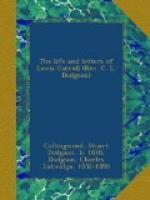each that has obtained the quota. If there are
still Members to return, let him name a time when
all the candidates shall appear before him; and
each returned Member may then formally assign
his surplus votes to whomsoever of the other candidates
he will, while the other candidates may in like
manner assign their votes to one another.
This method would enable each of the two parties in a district to return as many Members as it could muster “quotas,” no matter how the votes were distributed. If, for example, 10,000 were the quota, and the “reds” mustered 30,000 votes, they could return three Members; for, suppose they had four candidates, and that A had 22,000 votes, B 4,000, C 3,000, D 1,000, A would simply have to assign 6,000 votes to B and 6,000 to C; while D, being hopeless of success, would naturally let C have his 1,000 also. There would be no risk of a seat being left vacant through two candidates of the same party sharing a quota between them—an unwritten law would soon come to be recognised—that the one with fewest votes should give place to the other. And, with candidates of two opposite parties, this difficulty could not arise at all; one or the other could always be returned by the surplus votes of his party.
Some notes from the Diary for March, 1885, are worth reproducing here:—
March 1_st_.—Sent off two letters of literary importance, one to Mrs. Hargreaves, to ask her consent to my publishing the original MS. of “Alice” in facsimile (the idea occurred to me the other day); the other to Mr. H. Furniss, a very clever illustrator in Punch, asking if he is open to proposals to draw pictures for me.
The letter to Mrs. Hargreaves, which, it will be noticed, was earlier in date than the short note already quoted in this chapter, ran as follows:—
My Dear Mrs. Hargreaves,—I fancy this will come to you almost like a voice from the dead, after so many years of silence, and yet those years have made no difference that I can perceive in my clearness of memory of the days when we did correspond. I am getting to feel what an old man’s failing memory is as to recent events and new friends, (for instance, I made friends, only a few weeks ago, with a very nice little maid of about twelve, and had a walk with her—and now I can’t recall either of her names!), but my mental picture is as vivid as ever of one who was, through so many years, my ideal child-friend. I have had scores of child-friends since your time, but they have been quite a different thing.
However, I did not begin this letter to say all that. What I want to ask is, Would you have any objection to the original MS. book of “Alice’s Adventures” (which I suppose you still possess) being published in facsimile? The idea of doing so occurred to me only the other day. If, on consideration, you come to the conclusion that you would rather




